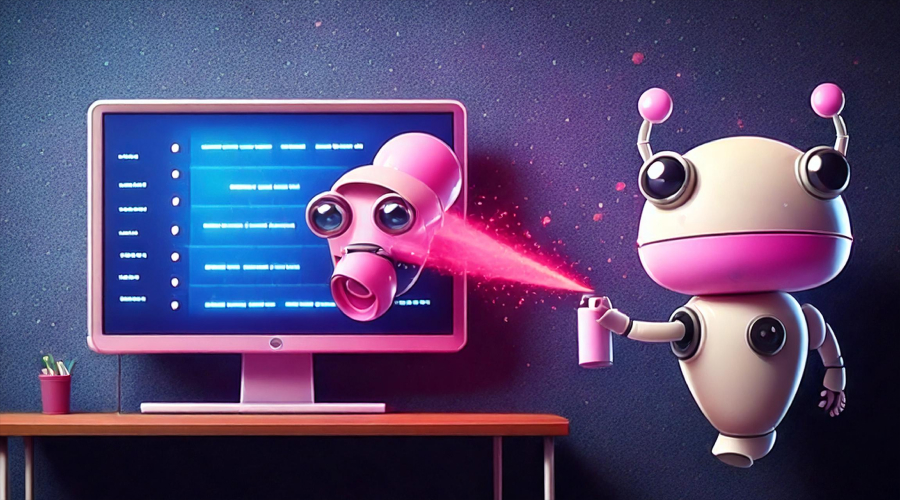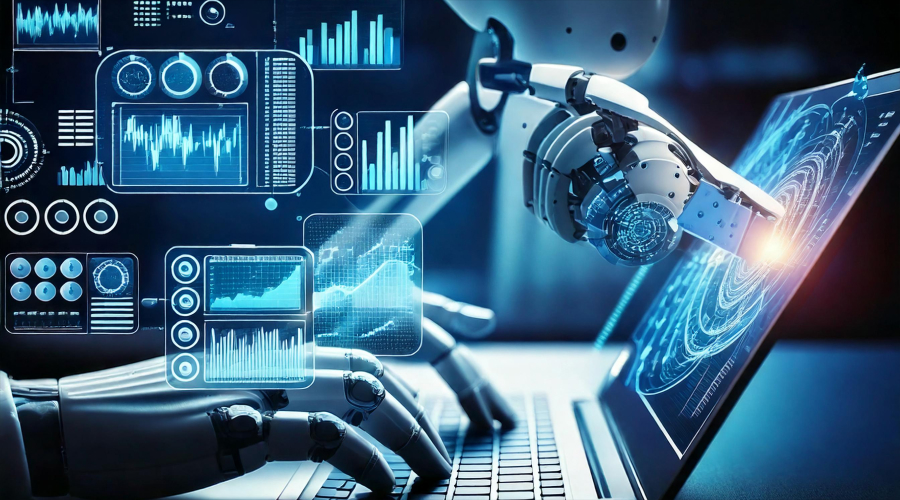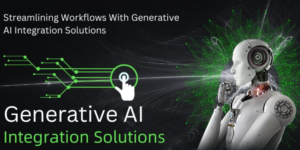
Of late, Generative AI has become an integral part of many projects, including software development. Its ability to improve software development efficiency is grabbing attention worldwide. It relies on streamlining intricate datasets and automating mundane tasks. Its power is not limited to generating texts and images for online marketing, product designing, and streamlining business complexities. It can do much more than that!
If you want to know how you can use AI in software development, then read this post. This article will discuss how a software development company India can stay ahead of the curve by leveraging the capabilities of AI to produce competitive software. So, read this article to learn how you can be more creative and innovative with AI software development testing tools. Let’s get started…
Table of Contents
- How Using AI Can Help In Software Development?
- Top 9 Ways To Use Artificial Intelligence In Software Development
How Using AI Can Help In Software Development?
Using AI in software development offers numerous benefits, in addition to enhancing efficiency and innovation. AI tools can automate repetitive tasks like code generation, testing, and bug detection, reducing human error and saving valuable time. AI also improves software testing through automated unit testing and predictive analytics, identifying bugs and anomalies early in the development stage.
Additionally, AI-based tools analyze large codebases to optimize performance and security, while chatbots provide 24/7 support during development phases. This allows developers to focus more on creative tasks and complex problem-solving, leading to higher productivity and better software solutions. Numerous software development companies now employ AI algorithms to generate or edit code and AI-based tools to automate other iterative tasks such as debugging, testing, and more. All in all, AI-based tools help in software development process and deliver better products in today’s competitive industry
Let’s now take a look at the best ways you can use AI in software development. Read on!
Top 9 Ways To Use Artificial Intelligence In Software Development
Here are the top 9 ways you can use Artificial Intelligence or AI-based tools for developing enchanting software. Read on for valuable insights…
1. Automated Code Review
Using automated AI code review and testing in software development recognizes potential problems and inefficiencies. It involves the use of machine learning algorithms to identify patterns and anomalies. This way, it optimizes code performance and mitigates the risk of developing severe issues.
AI-powered code review is known for its high speed and efficiency. The best thing about AI-powered code review is that it remains unbiased throughout the process. The key components of AI code review are static code analysis, dynamic code analysis, rule-based systems, natural language processing models, and large language processing models.
The advantages of using artificial intelligence-powered automated testing in software development include the following:
- AI algorithms feature automated and time-saving solutions. With AI code review, the developer can ensure the software’s quality assurance in a fraction of the time. AI can quickly run tests to check software’s functionalities, identify critical bugs, and make recommendations for refinements.
- AI consistently and unbiasedly recognizes flaws in software behaviour patterns. Throughout the process, it is not affected by the size or complexity of the database.
- It decreases the risk of subtle bugs reaching customers after the product launch.
- It reduces debugging time, allowing developers to launch high-quality software with zero risk of post-deployment difficulties.
- AI algorithms help developers enhance their knowledge and skills.
2. Prototyping
In software development, proper planning is vital to improve user experience affordably. Prototyping allows developers to enable testing iterations and improvements, resulting in a product that effectively meets customer needs. A prototype is a preliminary version of a product designed to test software design, features, and functionalities.
However, with the help of AI-driven tools, developers can enhance the speed and efficiency of iterations. AI algorithms are smart to explore different design possibilities, identify errors in the initial stage, and ensure user-centric software. Here are some advantages of using AI in prototyping. Take a look…
- AI aids developers in pinpointing design flaws in the initial development stage
- It reduces the overall cost of product development
- Ensures user-centric software by running various tests to measure functionalities
- Improves communication between the product development team and other employees
- Increases the chances of delivering a high-quality product to achieve a competitive advantage.
3. Debugging

Debugging is yet another way you can use AI in software development. Many software developers now use artificial intelligence tools to identify critical bugs that human reviewers may fail to spot. With AI technologies, developers can automate the debugging process, ensuring the product’s efficiency.
Conversely, the conventional debugging process is time-consuming and also labor-intensive due to manual iterative testing. It lacks the power of predictive analysis, which is essential to spot bugs. Moreover, conventional debugging can result in delays in product launches, causing missed market opportunities that are crucial for achieving a competitive advantage. Utilizing an AI debugger can provide the following advantages:
- AI tools automate the debugging process, allowing developers to focus on what is important
- It improves the overall usability and readability of software
- AI-powered debugging tools employ predictive analysis to point out subtle issues, preventing downtime, costly improvements, and delays in the product launch.
4. Generating Code Documentation
Code documentation is a vital part of software development. The process of code documentation streamlines complex datasets and aids developers in improving the code. It is a written or visual report used to describe and pinpoint issues and improve performance throughout the process. Developers can prepare it in various forms, such as comments, summaries, diagrams, and tutorials.
AI-driven code documentation tools can generate automated code documentation with natural language processing (NLP). It also uses fast image processing to create, edit, and format images and diagrams. With AI algorithms, it is convenient and efficient to translate and simplify coding documentation according to different languages, cultures, and contexts. Check out the following pointers to know the advantages of the automated code documentation:
- It quickly generates code visual or written reports, allowing developers to focus more on creative, innovative, and productive tasks.
- Clear and concise documentation improves the accuracy and usability
- Developers can utilize the saved time to streamline complex problems.
5. Refactoring Code
Using code refactoring, developers can alter the factoring and layout of the code, ensuring no changes to the software’s external behaviour patterns. It improves the quality, usability, and readability of the code. By integrating large language models (LLM), developers can initiate AI-driving refactoring to analyze complex problems and suggest the product’s optimizations. Contrary to manual refactoring, it ensures optimal results. Look at the following pointers to learn the key advantages of restructuring of the existing code:
- By consistently implementing coding standards, AI refactoring tools spot redundant data information, ensuring no risk of escaping that remains with manual refactoring.
- It improves the overall quality, modularity, and efficiency of the code
- It provides a clean and organized codebase, ensuring a proactive approach to fixing potential flaws
- Refactoring code helps developers follow ethical coding standards
- It enforces consistent and constant coding styles across different parts of a project
- It minimizes the time and effort required for easy-to-maintain code
- AI algorithms learn from code repositories to observe trends and outliers.
6. Predictive Analysis

Since the growing digital environment provides large and complicated datasets, classic regression analytical methods are difficult to follow to solve complex tasks. These days, developers use AI-powered predictive analysis to make accurate predictions and obtain high-valued insights.
This helps them leverage data-driven decisions that can enhance the efficiency of the software. For this, it uses machine learning algorithms with historical data and statistical models. These algorithms are less resource-intensive and less time-consuming. They analyze patterns, trends, and dependencies to identify potential risks within the project’s specific timeframe. Here are a few benefits of using AI-based tools for predictive analysis that you must be aware of:
- AI solutions help developers define realistic goals, future trends, and developments
- AI-powered predictive analysis helps understand project estimates, ensuring optimized resource allocation and on-time project completion
- It ensures a reduction in barriers or bottlenecks and an improvement in efficiency
- It easily adapts to the project development
- The integration of AI in predictive analysis provides real-time recommendations and predictions.
7. Maintaining Legacy Code
Old computer code, known as legacy code, is crucial in software development. Since the legacy code is backed by outdated technologies and lacks clarity, it is difficult for programs to run the code. Updating it might break or fail other parts. Therefore, bringing any changes to the code is difficult.
However, it is vital to revamp the legacy code to comprehend the intended features and designs of specific code segments. AI-powered LLMs (Large Language Models) come in handy in such a situation. With the use of AI assistants such as Copilot and ChatGPT, it is possible to get suggestions on code completions. However, it is crucial to examine them manually before incorporating them into your code. Check out the benefits of using AI in the legacy code:
- Helpful for filling gaps in understanding the code
- Provides alternative solutions to streamline difficulties
- AI tools can be used in pairing with other tools, such as debuggers, traditional analysis tools, and tests
- AI algorithms pinpoint issues in patterns and use a proactive approach to solve problems.
8. Code Explanation
Code explanation is yet another important aspect of software development. However, it is very difficult to analyze code manually. In such a situation, AI-powered tools turn out to be beneficial. Rather than manually analysing each line to understand the code’s meaning, AI-powered code explanation employs natural language processing (NLP) and machine algorithms to conduct the analysis. The best thing about them is that they produce human-readable explanations.
With these in-depth explanations, developers get insights into the code snippet’s objectives, designs, functionalities, and more. Platforms like GitHub Copilot, powered by AI, assist developers by suggesting code snippets and completing lines based on context. This allows them to work with vast, intricate, and strange codes without flaws. Common benefits of the AI-powered code explanation include the following:
- Simplify intricate databases to make the procedure understandable for a new developer
- Establishes an improved team collaboration to work on the AI-generated recommendations for code improvement
- Initiates standardized code discussions for delivering high-quality software to end users
- AI’s adaptive learning capacity understands developer’s needs and preferences to provide personalized code explanations.
9. Natural Language Processing (NLP) Integration
Last but not least, AI can be used to integrate natural language processing (NLP) into software development. NLP makes the codes intuitive and approachable to everyone. It allows developers to write codes in an easy-to-understand language. Moreover, it is a highly versatile tool that can be used in every kind of application, from simple to complex.
The best thing about using AI-powered tools here is that all programming languages are suitable for the integration of natural language processing. The most suited ones are Python and Ruby. Due to their readability feature making, writing codes in a human-written language like an essay becomes a breeze. Look at the following benefits of the NLP integration in the software development:
- Programming becomes more accessible and user-centric
- Lowers the barrier to entry for new developers
- Fosters more innovation and creativity
- Encourages more people to develop software
- Facilitates better coordination among the project team members
- Optimized codes for high-performing software
- Saves time and efforts
- Improves overall productivity with enhanced efficiency.
The Bottom Line
So, these are the different ways you can use AI in software development. Hopefully, this article has been informative and helped you understand various uses of artificial intelligence in software development. Slow-performing resources, time-consuming coding interpretations, and less reliable bug detection are the issues of the past for a mobile software development company.
AI-powered tools have made the process of software development a breeze for all. AI-powered tools automate data collection and analysis to pinpoint critical patterns, trends, and outliers. Using machine learning models ensures no risk of post-deployment difficulties. This way, artificial intelligence in software development improves team communication and collaboration. Also, it ensures that the software complies with standard industry ethics and safety.






